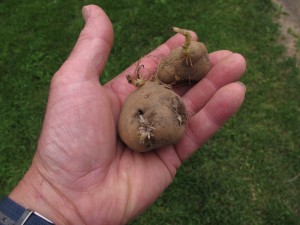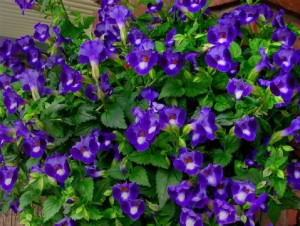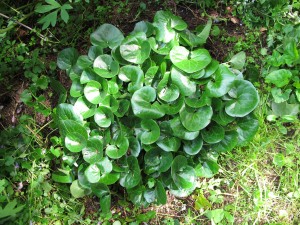Spicy, Zesty and Hot!
When I was a young man I lived in Africa and learned to love hot, spicy foods. In Cameroon, where I was a Peace Corps volunteer, the food was generally bland. Local folks ate ground corn, rice or cassava that was boiled up and only made interesting when served with a sauce made of leaves, spices and hot peppers – and very occasionally a little meat or fish. I was sometimes served pepper sauce so hot that it made me sweat and once I got uncontrollable hiccups along with the sweats. Habaneras? I bet some of the old boys could eat them like pickles. Now I grow hot peppers and horseradish to satisfy my need for hot and spicy.
Let’s start with peppers. Hot peppers would really rather be living in Mexico or Cameroon or even southern France. They do well in hot, dry climates and lousy soil. Or should I say, soil that is low in organic matter, and especially nitrogen. If you want to get peppers (and not just big plants and leaves), you should never give peppers fertilizer after they go in the ground. (I do give seedlings some liquid fish or seaweed fertilizer when they are growing indoors).
I grow a number of kinds of hot peppers most years. My favorite is one called the Espelette pepper, a name that the French government lists as controlled (sort of like the word “champagne” which can only be used to refer to bubbly wine from certain villages). True Espelettes come from just 11 villages in southwest France – and from Cornish Flat, NH, of course. The French dry Espelette peppers and coarsely grind them into a powder. They are about the same level of spiciness as jalapenos, about 4,000 Scoville units. Here in the States, Espelette powder sold on the internet costs about $8/oz. I’ve never seen it for sale in a store.
Chatting about gardening in my favorite restaurant, my server told me that she grows her peppers in cement blocks. She said that she fills the holes in the blocks with soil and plants into the blocks. Since the cement absorbs the sun’s heat, they do better than those grown in the soil, she said.
I knew that peppers like to be grown in close proximity to other peppers – though I have never understood why – and each cement block provides space for two peppers that are quickly touching leaves. So this year I’m conducting a comparison – some in the soil, others next to them in blocks. I made a mix of potting soil and compost to fill the blocks because I think straight garden soil would compact and stifle the roots. I’ll report back in the fall.
Then there is horseradish. Horseradish is in the cabbage family, but unlike its cousins, it is the root, not the leaves, that you eat. And unlike other crucifers, horseradish is not started by seed, but by planting a cutting. The Johnny’s Selected Seeds catalog, one of very few that offers cuttings, explains that the seeds are not viable. They ship cuttings in April, “after danger of freezing in transit has passed.” I called them, and they are currently out of stock until next spring. But you can also get cuttings from a friend and plant some now.
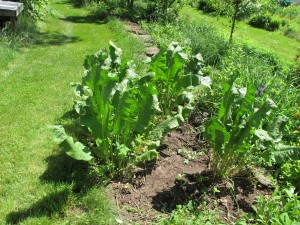 To prepare a cutting, dig up a root, cut off the leaves, and use the top 2 inches of the root to re-plant. Bury the starts about 2 inches deep and 12 inches apart. Prepare a horseradish bed by working in some well rotten manure or compost. That will improve soil texture and keep the soil looser – for ease in future harvesting. You can begin harvesting a year or two after planting.
To prepare a cutting, dig up a root, cut off the leaves, and use the top 2 inches of the root to re-plant. Bury the starts about 2 inches deep and 12 inches apart. Prepare a horseradish bed by working in some well rotten manure or compost. That will improve soil texture and keep the soil looser – for ease in future harvesting. You can begin harvesting a year or two after planting.
Horseradish does best in well drained soil, but really will grow anywhere. It will be most vigorous in full sun, but 4 hours is plenty. Horseradish, which is essentially a weed, doesn’t need high levels of nitrogen, phosphorus or potassium.
Once established, horseradish roots go down two feet or more into the soil. Because the roots branch and they are brittle, one can never get all the roots out. Even a scrap of the root will re-sprout, so the plants are there for life. Horseradish is as persistent as it is piquant. It doesn’t spread fast, but it spreads. I keep my patch under control with the lawnmower – it can’t spread into the lawn without being cut down.
To harvest, loosen the soil around a plant, either with a garden fork or a drain spade. Drain spades have blades that are about 16 inches long and 5 inches wide, and are great for digging out deep-rooted things like horseradish and some persistent perennial weeds. A mature root will challenge even the strongest backs, so you may need to sever the root with your spade to remove it.
To make a horseradish sauce, peel the root, chop into pieces, and place in a blender with vinegar. The fumes are strong, so do it outside. Pulverize it, adding vinegar until it is the right consistency, and store in the fridge. Your own will be better than the store bought stuff.
Other than planting, horseradish needs no labor from a gardener until it’s time to harvest. Now if tomatoes and beans were so easy, I bet we’d all have bigger gardens!
Contact Henry at henry.homeyer @comcast.net. And visit his Web sites, www.Gardening-guy.com and www.henryhomeyer.com.
Growing with Kids
By all rights, I never should have turned out to be a gardener. I tell parents that if they want their children to be gardeners when they grow up, that they should never make them pull weeds. My parents made me pull weeds. We had a vegetable garden and we all worked in it. Gardening was considered a duty, not a learning experience. They had lived through the Depression of the 1930’s and had a deep fear that the economy would collapse once again. Growing vegetables was a hedge against hunger. My grandfather saved the day by making gardening fun when I visited him.
If you want to encourage children to love gardening, I’d like to suggest that you give each child a piece of earth that is theirs to use as they see fit – to grow carrots or flowers, or even to use with toy trucks. The right size plot is probably, for smaller children, as big as they are – their height by their arm span. For little ones, that’s three or four feet square. It could be a wood-sided bed, or just a corner of the garden marked off by string.
Help your kids pick things to grow that are easy and tasty. I think most kids will eat cherry tomatoes right off the bush. Sun Gold is the name of my favorite – it’s delicious and highly productive. Buy a seedling and help your child plant it. These tomato plants get big and tall and will need some support. I recommend using a tomato cage made of heavy wire. Pick the biggest cage you can – 54 inches tall and with 4 legs, not 3. Later, you may have to add a tall wooden stake to help keep the plant from tipping over anyway, cage and all.
There really is magic in starting plants from seeds. Kids are fascinated by the idea of planting a seemingly inert speck and getting fresh tomatoes or carrots some months later. But they need guidance, and a certain amount of help. Carrots seeds, for example, are tiny and hard for small fingers to plant one by one. The solution? Buy pelleted seeds if you can find them. These are seeds that are coated with a layer of clay, turning a tiny seed into something almost the size of a BB. I had pelleted seeds for my grandkids to use this year, and it made a frustrating job fun. I ordered pelleted carrot seeds from Johnny’s Selected Seeds (877-564-6697 or www.johnnyseeds.com).
Radishes, beets and beans are bigger seeds and easy to handle, but not necessarily tops on the list of favorite veggies for kids. I love green beans now, but as a kid I only ate them under duress. Corn is easy to plant, but requires more space than you might want to dedicate to it, and is a magnet for corn worms which can be off-putting.
If you are working with kids, you surely do not want to use any chemicals in their little gardens. Not chemical fertilizer, not weed killer, not bug killer. Their systems are much more sensitive to chemicals than ours. Chemical fertilizers are not poisonous, but can be harsh on young fingers and the dust should never be inhaled.
In my experience, nothing is better to plant with kids than potatoes. They are easy to handle at planting time, and the excitement when harvesting is remarkable. And I’ve never met a kid that didn’t like eating freshly cooked mashed potatoes that they grew.
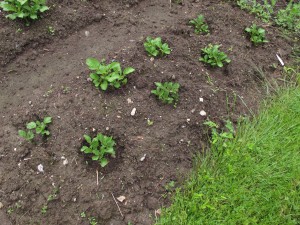 If you’ve never grown potatoes before, they’re easy. Start potatoes from sprouted potatoes that are sold as seed potatoes at your local feed-n-grain store or garden center. Don’t try growing potatoes from grocery store spuds because many of those have been treated with chemicals to keep them from sprouting. You can plant whole small potatoes, or cut larger ones into 2 or 3 pieces, so long as each has two “eyes” that are starting to sprout.
If you’ve never grown potatoes before, they’re easy. Start potatoes from sprouted potatoes that are sold as seed potatoes at your local feed-n-grain store or garden center. Don’t try growing potatoes from grocery store spuds because many of those have been treated with chemicals to keep them from sprouting. You can plant whole small potatoes, or cut larger ones into 2 or 3 pieces, so long as each has two “eyes” that are starting to sprout.
For best results, each piece of potato needs to be placed in loose, rich soil that has been amended with some compost.. The roots of your plants will grow down, and the new potatoes will be formed above the seed potato. Loosen the soil well and place your seed potatoes 3 or 4 inches beneath the soil surface and a foot apart in the row. Cover with a thin layer of soil – an inch is fine. Then, after the spuds have sent up leaves, you can fill in the hold or the trench you have planted in. That’s called “hilling” the potatoes.
Potatoes are remarkably productive. Each piece you plant will produce from one to five pounds of potatoes. And they come in a variety of colors – which kids find fascinating: get some purple ones or red-skinned ones to plant if you can. The variety called Kennebec is an all white potato that is, in my experience, the most productive of all. Yukon Gold is another good producer, as is Red Pontiac, one of my favorites for flavor.
Maybe I became a gardener because, like my parents, I feared that calamity would strike and I’d need to depend on my garden for food. It is true that I eat something that came from my garden nearly every day of the year – garlic, for example, or veggies from my freezer. And I don’t mind weeding – I even enjoy it in moderation. So try to get your kids gardening. It’s not too late to start, and I think you’ll all have fun.
Henry Homeyer is a grampy and former school teacher. His children’s book, Wobar and the Quest for the Magic Calumet, is a fantasy-adventure for all elementary school kids. His web site for that book is www.henryhomeyer.com.
Shade Annuals
Last fall a reader alerted me to the fungal disease that has devastated that wonderful shade annual, impatiens, throughout much of New England. The disease, called impatiens downy mildew, will be a problem again for most gardeners this year. Any garden that had the disease last year will have it again this year – even our coldest winters will not cleanse the soil of it. I wish I had known about it sooner, as prompt removal of affected plants may stop the spread of the disease. So if you did not have the disease last year, watch your plants carefully this year and bag and dispose of any diseased plants promptly.
Impatiens downy mildew symptoms are these: yellowing of leaves, then a limp appearance, as if it needs to be watered. Next comes a downy white fungal growth on the undersides of leaves. Then leaves and flowers drop, leaving just a stem with a few leaves on top – as if slugs had eaten the leaves. I have read that if you don’t plant impatiens in a site that has had the disease for a year or two, the soil may become free of disease. But I wouldn’t count on it.
There are two related plants that will thrive in shade or part shade and that are not susceptible to the mildew: New Guinea impatiens and SunPatiens, which is a trademarked hybrid. SunPatiens is advertised as good for part sun to sun – but not deep shade. But it is being marketed as a replacement of impatiens. I wonder if it will be able to bloom as vigorously as our old favorite in full shade. Both are generally sold in individual pots for around $5, quite an upgrade from a six-pack for $3.50 or so that I was accustomed to paying for impatiens in past years.
Another plant that is being touted as a replacement for impatiens is Torenia. I spoke to two landscapers who have used Torenia in past years and say that it is nice enough, but it will not satisfy impatiens-lovers. I’ve heard that it does not have as many blossoms per plant, generally, and is often available in just a few colors – shades of blue and purple, and in white. However, I have found it for sale in multi-packs in a few places and did find one nursery with 4-packs that listed rose, magenta, lemon drops and white as colors available.
I have used bedding lobelia as a nice shade annual, though in my experience it wants a little sun or filtered sun. I love the intense blue that it often displays, though it is available in other colors, too. I started seeds indoors back on April 17, a mix called ‘Cascade of Color’ that promised blue, blue with a white eye, lilac, red, ruby and white.
Right now my lobelia seedlings are only 2 inches tall but I assume they will take right off when I separate them and get them in the ground. The only problem with a mix like that is that one cannot determine what color any given seedling will be – unless you wait for them to bloom in the pot. And, when I read the seed packet (from Botanical Interests) just now, I see that this variety is advertised for full sun. I have plenty, so I’ll try some in shade, too.
So what else can we do to provide color in shade? Try some perennials. Granted, most only bloom for 1 to 3 weeks, but if you select plants with good foliage they can be a joy all summer. I love European wild ginger (Asarum europaeum) for its very glossy dark green leaves. It forms a nice expanding clump, even in dry shade with competition from tree roots. The blossoms are hidden beneath the foliage, but it doesn’t matter to me. This is a great shade plant. I plant them in clumps of three about 18 inches from center to center.
Then there is bigroot geranium (Geranium macrorhizum). Not to be confused with your mom’s red geraniums (which are technically not geraniums at all), this is a nice spreading plant that thrives in full shade and blooms with pink, magenta or white flowers in late May or early June. The leaves look good all summer, each plant a spreading mound 12 to 18 inches tall and 15 inches wide. I use it as a groundcover. I have read that it will do well in sun, too, and that it tolerates a wide range of soil and pH conditions. If it wanders too far? It pulls easily, and you can give the roots to someone who doesn’t have it.
I have never tried either the geranium or the ginger in a pot, but will this year and grow them on my north-facing, shady deck. I’ll give them a 50-50 mix of standard potting soil and compost, and I bet they look just fine.
It seems that every year there is a new bug or a new disease that threatens some plant in our garden. I guess we will have to keep on adapting and changing – just like the pests do. Good luck!
Henry Homeyer is the author of 4 gardening books and a children’s fantasy-adventure called Wobar and the Quest for the Magic Calumet. You may reach him at PO Box 364, Cornish Flat, NH 03746 or henry.homeyer@comcast.net.\




